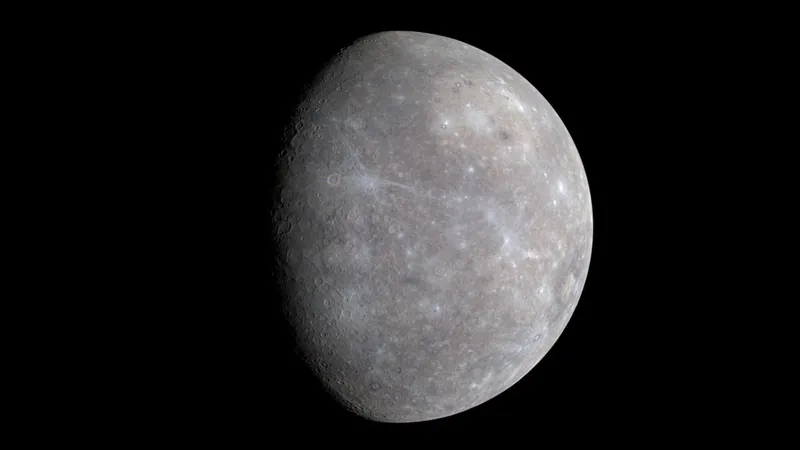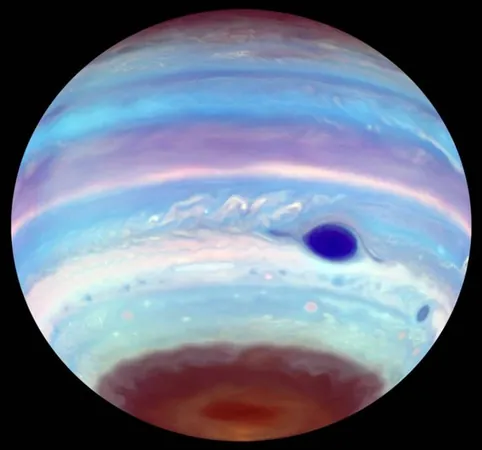
Did Mercury Get Its Unique Makeup from a Cosmic 'Hit-and-Run'?
2025-04-10
Author: Wei Ling
A Cosmic Collision with a Twist
Scientists are proposing a groundbreaking theory about Mercury's unusual characteristics, suggesting they originated from a grazing 'hit-and-run' collision with another protoplanet in the early solar system. This new study could turn our understanding of planet formation on its head.
Mercury: The Solar System's Enigma
As the smallest and innermost planet in our solar system, Mercury has baffled researchers for years due to its extraordinary density and massive iron-rich core, which comprises about 60% of its total mass. This is double the proportion found in other rocky planets like Earth, Venus, or Mars, leading scientists to question traditional theories of planetary development.
Unveiling the Mystery with MESSENGER Data
NASA's MESSENGER probe, which orbited Mercury from 2011 to 2015, provided crucial data indicating that Mercury's surface is rich in volatile elements such as potassium, sulfur, and sodium. These findings clash with prior theories suggesting a single massive impact would have stripped these components away.
A Different Kind of Collision?
Older hypotheses posited that Mercury might have collided violently with a larger protoplanet. However, simulations of protoplanetary collisions often reveal that such drastic size discrepancies are rare events. As a result, researchers have been investigating alternative explanations for Mercury's unusually dense structure and composition.
The Lucky Shot Theory
The latest simulations suggest that Mercury's formation might be attributed to a grazing collision with another protoplanet of similar size rather than a catastrophic impact. Lead author Patrick Franco from the Paris Institute of Planetary Physics describes this 'lucky shot' as not only plausible but potentially common in shaping the structures of planets in our solar system.
Timing and Impact Angle Matter!
Franco and his team's simulations reveal that the timing and angle of the collision were key factors in determining how much mass was lost from young Mercury. They discovered specific angles that allowed Mercury to shed the right amount of its outer layers, giving rise to its current composition without requiring multiple collisions.
Chaos in the Early Solar System
The simulations indicated that this 'hit-and-run' event likely occurred tens of millions of years after the solar system formed, when young planets had already established distinct layers. The chaotic and crowded environment between Venus and Earth was especially conducive to such incidents, suggesting Mercury might have started its journey further out before moving inward.
What's Next for Mercury Research?
The upcoming BepiColombo mission, a collaborative effort between the Japan Aerospace Exploration Agency (JAXA) and the European Space Agency (ESA), is on its way to Mercury and is set to arrive by November 2026. The data collected from this mission may challenge existing theories and ignite new discussions about the planet's origins and its long-term evolution.
Conclusion
As scientists continue to unravel the mysteries of Mercury's formation, it’s clear that the debate over the planet's origins is far from over. New insights promise to transform our understanding of how the planets in our solar system came to be.



 Brasil (PT)
Brasil (PT)
 Canada (EN)
Canada (EN)
 Chile (ES)
Chile (ES)
 Česko (CS)
Česko (CS)
 대한민국 (KO)
대한민국 (KO)
 España (ES)
España (ES)
 France (FR)
France (FR)
 Hong Kong (EN)
Hong Kong (EN)
 Italia (IT)
Italia (IT)
 日本 (JA)
日本 (JA)
 Magyarország (HU)
Magyarország (HU)
 Norge (NO)
Norge (NO)
 Polska (PL)
Polska (PL)
 Schweiz (DE)
Schweiz (DE)
 Singapore (EN)
Singapore (EN)
 Sverige (SV)
Sverige (SV)
 Suomi (FI)
Suomi (FI)
 Türkiye (TR)
Türkiye (TR)
 الإمارات العربية المتحدة (AR)
الإمارات العربية المتحدة (AR)